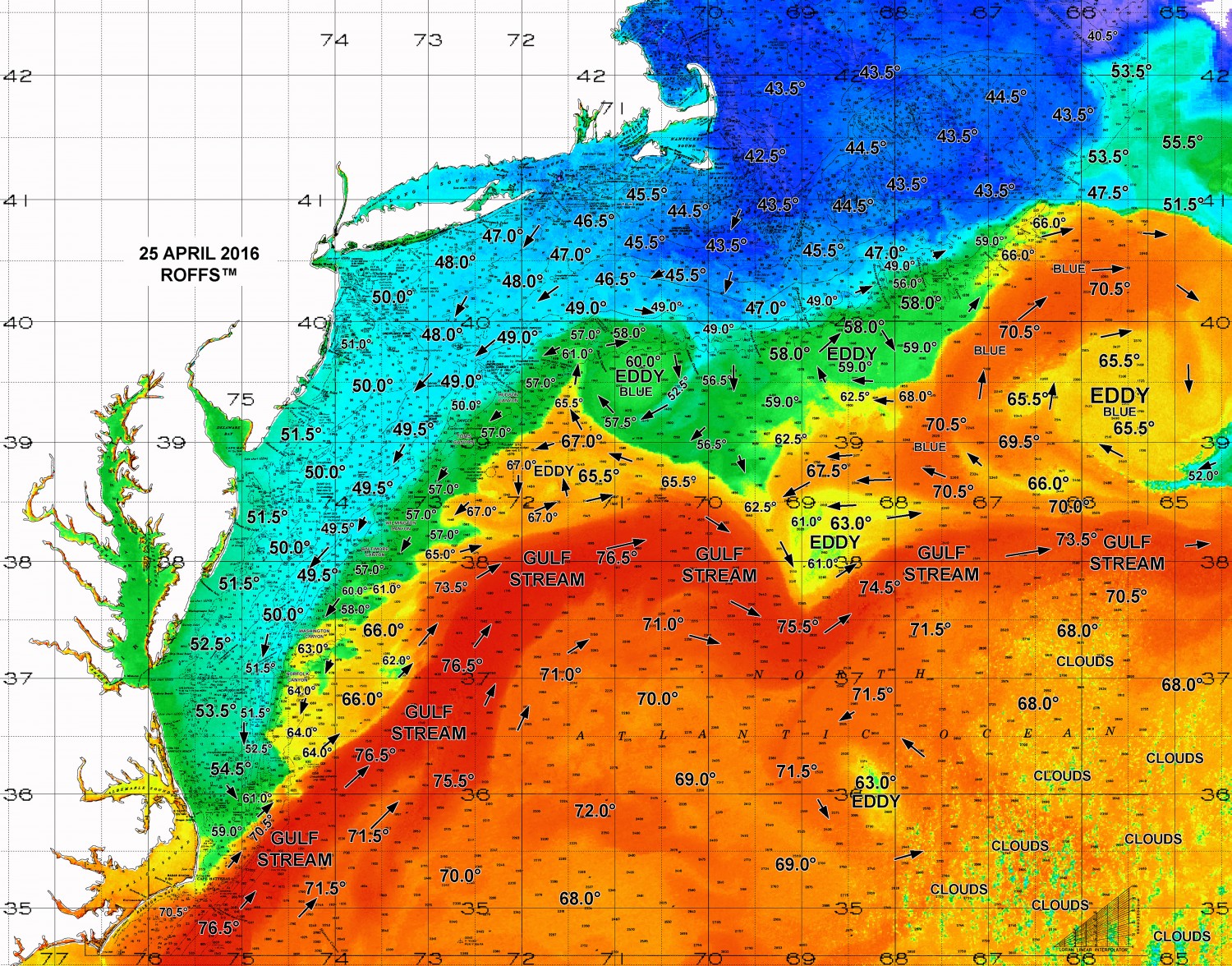Please click here to download FULL forecast as a PDF.
ROFFER’S OCEAN FISHING FORECASTING SERVICE, INC. TOLL FREE 800 677-7633 & (321) 723-5759 // WWW.ROFFS.COM
ROFFS™ FISHERIES OCEANOGRAPHIC ANALYSIS FOR THE NORTHEAST OFFSHORE AREA CAPE HATTERAS TO MASSACHUSETTS
UPDATED ON MONDAY 25 APRIL 2016 FOR A SPECIAL SPRING and SUMMER FORECAST
We are providing another complimentary analysis of the overview of the ocean conditions during the week of April 25th to try to get everyone excited and motivated for the upcoming fishing season. We are again focusing on the northeast offshore region from Cape Hatteras to Virginia, New Jersey, New York to Massachusetts including all offshore canyons to provide some insight on the upcoming fishing season. We have included some spot sea surface temperatures (°F) of the main water masses and located the main eddy features with arrows indicating the flow direction of the water. Bottom line is, summer is approaching quickly and the waters are warming up so NOW is the time to get your boats ready, do not miss out on some early season tuna, wahoo, dolphin, shark and swordfish action. Contact ROFFS™ and get the up-to-date integrated fishing forecasting analysis to locate the best fishing conditions near you.
We have been monitoring the ocean conditions throughout the past two months and continue to be encouraged by the way the position of the Gulf Stream and the multiple Gulf Stream warm core eddies are lining up for a productive and hopefully consistent late spring, summer and early fall fishing season. There are three main eddy features to keep an eye on. First of all, as suggested last week, the clockwise rotating eddy that is now offshore of West Atlantis to Block Canyon continues to move slowly westward, has indeed interacted directly with the Gulf Stream water and is now pulling 61.0°F to 65.5°F/67.0°F warmer water in a favorable inshore direction directly into the Lobster Claw and Block Canyon areas and toward the Fish Tails and Middle Grounds creating promising spring fishing conditions for tuna, sharks and swordfish in these areas as soon as this weekend and into next week. With the proximity of the direct Gulf Stream water to the south (70.0°F to 76.5°F) this eddy is likely to continue to pull up warmer Gulf Stream related water as this eddy drifts westward and then southwestward and should be pushing into Hudson Canyon within the next two to three weeks. As this eddy continues to move southwestward, the water associated with it is likely the favorable waters the New Jersey, Maryland and Delaware crowd will be fishing over their canyons in the early summer.
Second of all, farther east we continue to follow another large Gulf Stream clockwise rotating eddy southeast of Georges Bank. If this eddy remains intact and starts its traditional westward movement, it should eventually bring good conditions to the northern canyons throughout the summer and then to the more southern canyons (Toms to Washington) during the late summer to fall season.
Thirdly, there is a smaller but equally important clockwise rotating eddy offshore Oceanographer to Hydrographer Canyons also starting to pull up some warmer mixed/blended 62.5°F to 68.0°F water toward the Hydrographer Canyon. In conclusion, as you can see there are now three promising features that should impact the offshore canyon region from offshore of Massachusetts to Virginia through the spring to summer months.
Offshore of New Jersey, Delaware, Maryland and Virginia, we continue to be excited about the proximity of the direct Gulf Stream water and filaments (66.0°F/67.0°F to 73.5°F/76.5°F) to the canyon regions with 60.0°F to 64.0°F water as far inshore as 250-500 fathoms in the Washington to Norfolk Canyon regions. This is the same 60.0°F-65.0°F water that we received reports of tuna and sharks in the Poor Mans to Baltimore Canyon areas last week. In fact, within the past two months we have noticed three different mixed Gulf Stream pulses offshore of the Toms Canyon to Wilmington Canyon to Baltimore Canyon areas that have likely already started to populate the offshore canyon regions with bluefin tuna, bigeye tuna, mako sharks, swordfish and even yellowfin tuna. We actually just received confirmation of some bluefin tuna, yellowfin tuna and mako sharks being caught offshore of Delaware recently. Keep in mind that with the proximity of the direct Gulf Stream water to the canyon regions in combination with the rising atmospheric temperatures, the ocean conditions can improve rapidly and we fully expect them to improve substantially over the next few weeks. It is also important to keep in mind the big picture, as the nice tuna, mahi, wahoo and mako sharks they are catching right now offshore of North Carolina are not too far away and in similar waters that are off of the coasts of Virginia to Maryland and Delaware in 500-1000 fathoms. Furthermore, we have has multiple reports of nice yellowfin tuna being caught offshore of Florida and in the Gulf of Mexico that have been related directly to the Gulf Stream water. These fish are migrating northward and are likely already within the Gulf Stream waters you see in this analysis. Remember, during the months of May and June over the past couple of years from Hudson Canyon to Norfolk Canyon offshore areas were the best months for yellowfin tuna action, so do not hesitate to get offshore as soon as the weather permits.
Verbal updates are free between 10:30 AM and 11:59 AM (eastern time) only, please call. Thank you for not sharing this analysis with non-paying fishermen. We survive on your honesty. SPRING HOURS: Mon. – Fri. 9:00 AM – 6:00 PM. We are open on Saturday’s in April ONLY based on demand by Wednesday at 5:00 PM. Remember you can order and/or purchase your fishing analyses from our website (https://roffs.com/) or by email (fish7@roffs.com). The ROFFS™ Graphic analysis is on the next page.
Please click on image below to see larger view.






